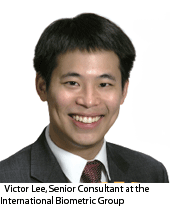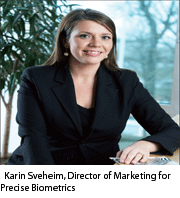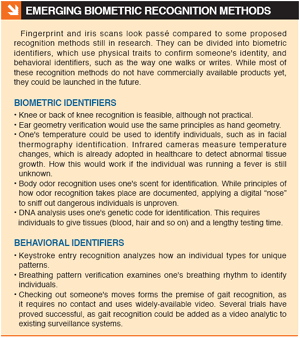Biometrics ranks as one of the hottest fields in security today. The sector has grown explosively in the past two decades, with technological innovations, a number of acquisitions and falling prices on equipment. A&S talks to industry players to find out what's next for this exciting sector.
Biometrics ranks as one of the hottest fields in security today. The sector has grown explosively in the past two decades, with technological innovations, a number of acquisitions and falling prices on equipment. A&S talks to industry players to find out what's next for this exciting sector. Imagine never having to remember keys, recall number codes or shuffle through cards again. Instead, simply present yourself perhaps your finger, face or iris for instant verification and access to what you want. Using physical traits to check someone's identity forms the basic premise for biometrics, which has grown into a significant market for security.

The International Biometric Group (IBG), which conducts biometrics research, predicts global biometric revenues to grow to US$7.41 billion in 2012 from $3.01 billion in 2007. "In the biometrics industry, the government sector has been particularly active, especially since Sept. 11," said Victor Lee, Senior Consultant at IBG. "A lot of the government sector work in biometrics is geared towards Civil ID (e.g. national ID cards, visas, passports) and border control applications."
The biometrics market has undergone blistering growth, with Frost & Sullivan estimating 2006 revenue growth rate at 83.1 percent, said Navin Rajendra, Analyst. "Corporate security and government ID time attendance projects accounted for 60 percent usage of biometrics in 2006."

Widespread use of biometrics by governments has led to increased market growth, according to IMS Research. "Biometric companies are trying to make sure that their technology fits applications," said Paul Everett, Senior Research Analyst for IMS Research. "This is the key point, which will help market growth. Moreover, governments are now promoting the technology as a way of increasing public security."
Along with market growth, the biometrics industry has been a hotspot for acquisition activity. Among the more notable ones is the merger of Viisage and Identix to form L-1 Identity Solutions in August 2006. L-1 has made other acquisitions, buying Canadian Bioscrypt for $44 million in January. With more widespread adoption of biometrics and continued acquisition activity, biometrics is a key industry to watch.
Worldwide Demand for Biometrics With security threats requiring precise identification, biometrics are being deployed globally.
Union Community, a Korean provider of biometric solutions for commercial and residential uses, has enjoyed strong export revenues. "Our finished products are sold to more than 50 countries, with end users like construction and building management companies," said Peter Park, Manager in the Overseas Sales Division. "Major overseas markets include Japan, Vietnam and the Middle East."
This reflects the adoption of biometrics worldwide, with more activity in the North American, Far East Asian and European regions, compared to the African and Latin American regions, said Lee. "Some regions are more privacy sensitive, especially in the Western Hemisphere. This can slow the adoption of biometrics." Asia and North America are expected to be the largest global markets for biometric products and services, according to IBG's Biometrics Market and Industry Report 2007-2012.
"Other regions, such as in southeast Asia, have governmental structures that are more authoritative and/or security-sensitive so that their regulations may often take precedence over privacy concerns," Lee said. "Far East Asia, particularly China, South Korea and Japan, has been especially active in recent years."

Biometrics is finding its way into a wide range of applications, providing speedy and accurate identification. "Major markets include airports, education, finance, gaming, government, healthcare, hospitality, manufacturing, quick serve restaurants, retail and transportation," said Jon Mooney, General Manager, Ingersoll Rand Security Technologies, Schlage biometrics.
While biometrics have been adopted widely, there are certain factors limiting its growth, such as privacy. "I would not say that any particular sector has shunned biometrics," Lee said. "There is variation, however, as to what is deployed and by whom."
Fingerprint Dominates The fingerprint is one of the most mature biometric recognition technologies. Thus, most solutions on the market are fingerprint, which are mostly deployed in time and attendance, access control and locks.
"Fingerprint biometrics will continue to be the dominant biometric recognition method in the coming years globally, although the percentage of adoption will decrease as a result of an increase in the percentage of adoption of other biometric recognition methods," Rajendra said.
As fingerprinting is stigmatized with its association to crime, other biometric recognition methods are becoming more mainstream. "The most dominant technologies currently are fingerprint, facial and iris recognition," Lee said. IBG reported in 2006 that fingerprint is expected to gain 38.1 percent of the non-AFIS (automated fingerprint identification system) biometrics market in 2007, followed by face recognition at 19 percent and iris recognition at 7.7 percent. "These three technologies are often favored for large-scale usage because of their dual capability to do authentication and identification."
For biometrics providers with fingerprint solutions, they work to distinguish themselves by their recognition method or algorithm, such as Sweden's Precise Biometrics. "We are specialists and providers of fingerprint recognition solutions," said Karin Sveheim, Director of Markets for Precise Biometrics. "Our core technology is the Precise BioMatch the algorithm on which all of our solutions are based."

This gives Precise Biometrics an edge over its competition. "Since we have specialized ourselves on fingerprint recognition and smart cards for more than 10 years, our algorithm offers outstanding performance on several card platforms when it comes to time and accuracy," Sveheim said. "We also have the highest number of contracted Match-on-Card licenses on the market."
Precise Biometrics' fingerprint readers are just part of its product portfolio. "Our main focus is licensing our software for fingerprint recognition," Sveheim said. "We are working towards several market segments. Some of our most prioritized markets segments at the moment are national ID cards, the banking and finance industry, and travel and aviation industry."
CEM Systems provides its biometrics solutions in a range of applications. Its iris recognition solution was implemented at Manchester Airport in January (see box on page 86). The project was approved for efficient identification.
Continued breakthroughs in recognition algorithms make fingerprint identification a mature biometric technology. The dominance of fingerprints is unlikely to go away, along with the market demand for integrated fingerprint solutions.
Sensor Technology The assumption behind fingerprinting is that no two prints are alike, even between twins. Fingerprints are formed during pregnancy, as the embryo develops friction ridges that are permanent and unique. These friction ridges remain unchanged throughout life, with the exception of scars or injuries, making them lasting identifiers for humans.
Fingerprint scanning can be divided into two major categories of live scan capture technologies. All of them essentially capture the ridges and valleys of each individual's fingers. The two main groups of fingerprint scanners are solid-state fingerprint readers and optical fingerprint readers. The first deploys silicon chips, while the second operates as a digital camera, using visible light to capture an image with either a complementary metal oxide semiconductor (CMOS) or a chargecoupled device (CCD).
Sensing the electrical charge on individual fingers is how capacitive sensors perform fingerprint recognition. As the air between the ridges and valleys of the finger produces different electrical charges, this creates a distinctive template for different individuals.
Similar principles are used for ultrasonic sensors, which originate from medical ultrasonography. Sound waves bounce back from the depressions in a person's fingerprints, creating a specialized sound signature. All image capture methods require contact with the finger, which distorts the skin. This makes each fingerprint scan different, as different pressure or how the finger comes in contact with the sensor affects how a three-dimensional finger is captured by a two-dimensional scanner.
Fake fingers are another concern, prompting liveness checks through thermal scans or near infrared scans for vascular patterns.
Differentiating Between Biometric Solutions To capture biometrics as accurately proprietary image capture methods. For FingerTec of Malaysia, it opted for optical scanning.

"Utilizing an optical scanner equipped with a 500 dpi CMOS camera for our normal readers and an URU sensor for our plus series, the FingerTec reader captures one fingerprint template in less than two seconds with one-to-many verification methods, providing convenience to every client," said Teh Hon Seng, CEO of FingerTec.
On the other hand, some makers have combined optical and semiconductive sensors. "We have patentpending technology that combines two sensors one being optical and the other being line (semiconductive)," Park said. "Using two sensors ensures that fake fingerprints do not fool the readers because optical sensors cannot detect paper or film and semiconductive ones cannot detect rubber or silicon."
Along unique sensing technologies, making sure the support software for the solution interoperable makes a solution suitable for many applications. Precise Biometrics makes its fingerprint and smart card technology work on non-proprietary smart cards. "Our Match-on-Cardtechnology is not only available for native integration to the card operating system, but also for Java, Multos and .NET cards," Sveheim said. "This offers great advantages, as applications and applets can be loaded onto the card at any phase of a project."
Finally, just keeping products clean can be a crucial differentiator as possible, different vendors use for biometric hardware. Schlage's HandKey and HandPunch platens use antimicrobial technology to prevent the spread of microorganisms. Mooney said.
Hand Geometry Sizes Up Identity
An alternative to fingerprinting is hand geometry. Instead of identifying a person by their fingerprints, the measurements of their hands are taken, providing a larger area to measure and a scalable amount of security. For example, tolerance for small cuts can be fine for a gym, but not allowed in a nuclear reactor.
"We are always reviewing various types of biometric technologies," Mooney said. "However, hand geometry and fingerprint readers cover 80 percent of biometric access control and time and attendance applications."
Schlage's flagship products are the HandKey and HandPunch hand geometry readers. Frost & Sullivan ranked Schlage the world's largest supplier of biometric terminals, Mooney said.
Alternative Biometrics Seek Spotlight
While hands and fingers comprise the lion's share of the market, other parts of body are also under consideration for identification (see box on page 89). Rajendra said, "After fingerprint identification, facial biometrics was the next most widely used biometric method, close to 24 percent." Facial recognition is being specified, as it uses existing two-dimensional photos for recognition or creates a three-dimensional template.
According to IBG, vein recognition is expected to comprise more than 10 percent of access control market. Vein or vascular recognition uses near infrared light to detect blood vessels. Hitachi makes vascular scanners for finger veins, which are compact. As vein patterns are underneath the skin, the scanners are not affected by dirt, water or wounds.
Vascular patterns are harder to fake than fingerprints, as the scan requires a living person who is circulating blood. While fingerprint ignitions for high-end automobiles have been touted, some tragic incidents are prompting more secure biometrics. In March 2005, Malaysian carjackers removed the left fingertip of an accountant to start his Mercedes Benz. Had a liveliness test been required by the car's fingerprint scanner, the carjackers would not have inflicted bodily harm on the owner. With its "liveness" scan, vascular technology has some advantages over older biometric methods. Palm scan identification the whole hand for its vein pattern.
Other verification methods include iris recognition, as each iris is unique a concept discovered by ophthalmologists Leonard Flom and Aran Safir in 1985. IBG predicted annual iris recognition revenues will approach $400 million by 2010.
"Iris recognition is one of the most sophisticated technologies in respect to biometrics performance," Lee said. "Some of the leading iris recognition vendors include OKI (Japan), LG (Korea), and Panasonic (Japan)."
Governments Embrace Biometrics
The rollout of biometrics has largely been though governments, making biometrics widely adopted and standardized. They are being required as proof of identification more and more in e-passports or national ID cards.
"The ICAO (International Civil Aviation Organization) specified that new e-passports should have the ability to support facial recognition," Lee said. "This choice makes sense, as facial recognition is something we already do naturally and is a practice with which we are relatively comfortable."
Biometrics for screening purposes is already used in the Registered Traveler program, which piloted in 2005 and continues in several U.S. airports. For a fee, travelers can bypass long lines, not remove their shoes and not take out their laptops. They must undergo a biometric verification, which depends on the airline and airport. The program's use of biometrics has helped frequent fliers cut down on travel time.
Canada's Nexus Air was launched in 2004 for travelers between Canada and the United States. Approved travelers also pay a fee and undergo an iris scan, speeding up customs clearance.
Another multinational rollout of biometrics is the European Union's BIODEVII pilot program, aimed at using biometrics to reduce visa fraud, prevent identity theft, combat terrorism and curb human trafficking. The FBI selected Lockheed Martin in February for a $1 billion biometrics database. Lockheed Martin already maintains the FBI's 10-fingerprint database and will likely store more biometric identifiers to keep track of terrorists, criminals and foreign visitors.
Product Trends
Putting together a good biometric solution depends on user needs, but some overarching principles apply. Throughput is one of them, Mooney said, which refers to how many people can be processed with the least errors possible. Errors include rejecting authorized individuals, resulting in high false rejection rates, or admitting unauthorized individuals or possible high false acceptance rates. While it is not as important for small applications with less than 100 people, it can be a significant inconvenience in places with 50,000 to 250,000 daily transactions like San Francisco International Airport.
Evaluating the usage area allows the provider to offer the best solution, Sveheim said, not just poring over technical criteria like measurements for false accept and reject rates, which have to be put into the appropriate context to make sense. "There are naturally different criteria on a national ID card than on a bank solution for employees using their fingers to access their computers."
Another factor is cost efficiency and the biometric solution's return on investment. "When choosing a biometric solution, customers often want improved cost-efficiency or a positive return-of-investment," Sveheim said. "As an example, the U.S. State Department is saving $7 million each year, according to their own calculation, on return-ofinvestment on replacing traditional passwords with fingerprint login to computers and networks."
Other important components include flexibility and interoperability, allowing fingerprint readers to be easily replaced during different phases of large-scale projects, Sveheim said. Scalability should also allow a solution to grow with additional users.
A growing trend is biometrics in e-payment, to authenticate customers are who they say they are. Several Indian and Indonesian banks specializing in microfinance are using biometrics and smart cards, so illiterate patrons do not need to fill out paperwork, according to a Financial Insights story.
Similar multimodal solutions are poised to be commonplace in the future. "There is a general trend is toward mobility and multimodality," Lee said. "Even multifactor applications (biometrics combined with other technologies, such as PINs or smart cards) are increasingly of interest, especially as biometrics become more established."
Next Steps for Fingerprint Providers
With more providers of fingerprint solutions competing for a limited number of contracts, staying competitive requires planning. For some vendors, increased communication is part of their plan.
"Fingerprint technology is today a mature technology being deployed in security demanding large scale projects such as national ID cards," Sveheim said. "The challenge is to communicate this to the market. Some segments still believe that fingerprint recognition is an immature technology when it really isn't."
Merging biometrics with other technologies also provides added security. "Integrating biometrics with cards and/or smart cards is fast becoming the de facto access control solution," Mooney said.
Breakthroughs in storage for smart cards allow for smarter biometric solutions that are suited for demanding environments in the future. "As costs of smart cards are coming down and their usage is more widespread, biometric devices can leverage the secure data storage they provide," Mooney said. Having scalable networked solutions, such as Precise Biometrics' smart cards which can instantly load applet and upgrade a system, are a few strategies for fingerprint providers to stay ahead.
Challenges at Hand As biometrics is maturing, it faces some growing pains. They include privacy, increasing awareness and standardization. While number of standards are in place, but more needs to happen, along with addressing privacy issues. "The standardization of biometric technology continues to be a challenge for the industry," Rajendra said. "Privacy concerns have long been a challenge for the biometrics industry and will continue to do so in the coming years."
Simply making money will require a long-term strategy. "I think the potential to achieve profitability is there," Lee said. "This might not happen in 2008, however. I think it's going to be challenging, as this is not an industry where profits are rapidly made. It takes time."
Along with the industry slowing down , a worldwide market downtown could affect biometrics. "Also, as the markets as a whole are beginning to slow down, particularly in the United States, governments will likely be a little more careful with their resource allocation," Lee said.
But for some industry players, they feel prepared for the future, with plans to ensure they stay around. "We have been profitable since 1994 and are part of a $10 billion a year corporation," Mooney said. "We do not OEM (original equipment manufacture) our hand geometry technology from another supplier and we are not dependent upon a third party for support of our terminals."
While a slump in global markets could impact the biometrics industry, overall demand for biometric solutions looks strong. As biometrics offers a secure way to authenticate identity, it promises to be a fixture on the security landscape.